Chapter 4 (cont.)
The Synagogue and the Community's Religious Life (cont.)
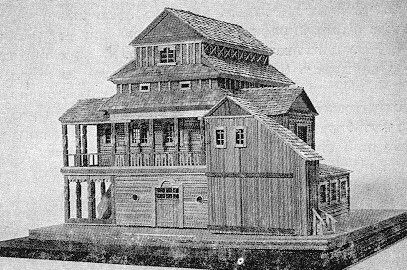
Model of the Wooden Synagogue of Yurburg
The model of artist Moshe Verbin, member of kibbutz Yakum, a
reconstruction of the synagogue in Yurburg.
This model, made of
straw, was made on the basis of two sketches, one of Andreoli
dated 1872, the other of Chekarsky, dated 1903.
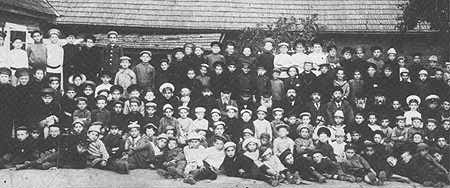
"Talmud Torah" students with their Rabbis, 1913 (Students only)
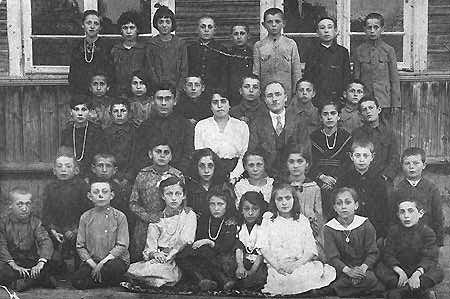
"Tarbut" elementary school 1920
Its founder and principal Bakin sits on the right, the
teachers next to him.
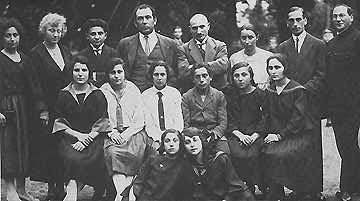
The highest grade of the Gymnasium in the first year of its
existence (without external students)
The teachers - from right;
Kaplan (gymnastics), Lifschitz (Natural Science), Mrs.
Efrat-Rosenboim (Languages),
Zentkovsky (Tenach), Dr. Efrat
(Principal, Mathematics) Kosotzky (Literature); (X - x)
The students - from right: Dartwin, Kobelkovsky, Zevulun P.,
Hannah Feinberg (x - ? ),
Shlomowitz; below to the right - Hinda
Levinberg, Clara Petrikansky
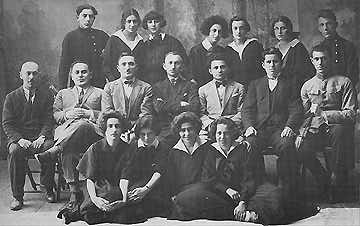
Eighth grade of the Hebrew Gymnasium, students and
teachers
The synagogues constituted an important center in the Jewish
communities of the Diaspora at all times. The synagogue was not
only a place of worship and Torah study, but also the center of
the community's religious and social life. It was the home of the
wise Bible scholars and harbored the organizational and social
institutions of the community, such as the various charity
institutions, soup kitchens etc.
Jewish history teaches us that once a Jewish community was
founded and settled somewhere, a synagogue was immediately
erected. At first, it was a small building, enough for a minyan
(quorum of ten adult male Jews), and as the community grew, so did
the synagogue.
We do not have the exact dates as to when synagogues were
erected in Lithuania or Yurburg, our town. No community was formed
according to plan, or at a specific date. From the events of
general history we know that the Jews of Germany were driven to
the land of Lithuania in the twelvth and thirteenth century,
following the Catholic-Christian persecutions at the time of the
Crusaders. Lithuania's residents, still divided into tribes at the
time, were pagans and did not oppose the German Jewish settlers'
taking hold of the land, realizing that the cultural level,
craftsmanship and commercial talents of the Jews would be helpful
to the Lithuanian groups in their villages.
From the direction of eastern Europe too - from Russia - waves
of Jews arrived in Lithuania, due to hardship and sometimes also
at the invitation of the rulers (Vitautas -1399). Thus over the
centuries Jews from west and east gathered in the land of
Lithuania, looking different, speaking a different language, and
with different customs. It is presumed that the Russian Jews
arrived in Lithuania first; they spoke in Slavic dialects, Russian
in particular. The Russian Jews brought along special Jewish
customs and tradition. The persecuted German Jews who arrived in
Lithuania also had a rich cultural-Jewish background, their own
customs and tradition. The German Jews spoke Yiddish, a German
dialect interspersed with Hebrew words.
Hundreds of years passed until the two divisions - the eastern
(Russia) and western (Germany) found a common language and merged.
In the past hundreds of years nothing is left of the Lithuanian
Jews' roots and only the family names are a sign of their origin.
Names such as Greenberg, Goldman, Weinstein, Ziman etc.
indicate the German origin, whereas names such as Ansky, Kobelsky,
Lotzky, Ritov, Riziov etc. are evidence of their Russian roots.
The merging process which affected all the Jews of Lithuania, of
course also affected the fathers of our town of Yurburg.
Therefore, the process of composing the Jewish communities in
Lithuania was very lengthy.
When the Lithuanians became Catholic Christians, hatred of Jews
increased in Lithuania. The Catholic Christians considered the
Jews as their competitors in trade and crafts. Nevertheless, the
Lithuanian Jews did not suffer from persecution or expulsions,
except for one short expulsion, in 1495. After eight years of
expulsion the Jews returned to their places of residence and their
belongings were returned to them. The Jews in Lithuania also
had privileges, among them the privilege to erect synagogues, on
condition they were built of wood, at the same height as the
buildings around them, and did not stand out. It is quite
probable that in the fifteenth and sixteenth centuries synagogues
were already erected in the Jewish communities of Lithuania and in
Yurburg too. Accurate numbers regarding Yurburg's population only
exist from 1766. In that year Yurburg had 7391 inhabitants, 2833
of them Jews. At that time synagogues already existed in Yurburg,
although we do not yet have any details as to the life of the
Jewish community here.
*
The great synagogue in Yurburg was built in 1790. It was a
large and magnificent building. In 1870 the synagogue was expanded
and renovated. On its upper level the women's section was
installed and downstairs the prayer room. On the attic a room was
set aside for welcoming distinguished guests.
From the eighteenth century there were already famous Jewish
craftsmen in Poland and Lithuania, builders, such as Simcha-Haim
Ben Habanai, Shlomo Malotzak, David Friedlander from Lodmior and
Benjamin Malasak. These builders specialized in wood building and
they also built a number of famous synagogues in Lithuania. The
price of building wood in Lithuania was cheap, for there were
plenty of forests around the Jewish communities.
From the research carried out by engineer David Kotliar,
published in the Lithuanian Jewry's Book of Remembrance, we learn
that the builders, mentioned above, were those who built the great
synagogue in Yurburg.
The Yurburg synagogue was one of the most beautiful buildings
from the architectural point of view, and all those who saw it
were impressed. It was erected at the end of a broad square and
looked very special. Its roof was composed of three slopes,
slanting onto each other, creating an interesting architectural
combination. Upon entering the synagogue, one could see the
traditional petitioning dome over the pulpit which brings to mind
the "east" and the land of our fathers. The Holy Ark was
particularly impressive - its magnificent wood carvings were
carved in a splendid ornamental style and considered popular art
creations. The prayer pillar and Elyahu's chair were also
tastefully installed.
The picturesque building of the synagogue drew the attention of
artists and painters from Lithuania as well as from abroad. In
1850 the famous painter Andreoli came from Italy and painted the
Yurburg synagogue. He was enchanted by its special architectural
structure and the composition of the wood carvings inside. The
picturesque motives and the colors of the plants interwoven with
animals - deer and lions - and the figures and symbols that have
been holy to our people for generations, such as the Tables of the
Testimony, the Candelabrum, Star of David etc. were also most
impressive. Anyone entering the synagogue stood in awe of the
splendor and magnificence he beheld. The Jews of Yurburg were very
proud of their synagogue.
Zusiya Efron, the researcher of Jewish art, writes the
following in the album "Wooden Synagogues in Poland and
Lithuania": "Until World War I there were 350 wooden synagogues,
and in the period between the two world wars about 100 wooden
synagogues were still standing, some of them outstanding
architectural creations. Among these synagogues the synagogue of
Yurburg, Wolfa and Narobala were particularly splendid. In the
Holocaust the Nazis and their helpers destroyed the last remaining
synagogues and nothing is left of them at present."
*
In the spring, summer and fall, the synagogue abounded with
worshippers who loved the building and its special atmosphere.
Only in the cold winter days, when there was ice and snow, the
synagogue was totally empty. When it was very cold, the
worshippers huddled together in the warm house of prayer and the
three small synagogues, the "kloisim" of craftsmen and small
traders. The "kloisim" also served as "hedarim" (religious
elementary school) of the schoolchildren. About twenty children
studied in our time in these "hedarim" with Rabbis, according to
the old version.
About two hundred children studied at the "Tarbut" school which
was a nationalist-Zionist school in spirit. At this school general
subjects were taught - Hebrew in Hebrew.
The former name of the elementary school was "Talmud Torah",
here mainly Jewish subjects were taught. This was a sort of
"upgraded heder". Between the two world wars "Talmud Torah" became
a modern elementary school, according to the State Laws, and at
the wish of the parents, and it was called "Tarbut". Two Rabbis,
Bible scholars, taught the Jewish subjects, they are fondly
remembered - Arie Leib (Leibzig) Gut and Rabbi Haim-Nathan
Yoziper. The other teachers and principals were graduates of
Teachers' Colleges, in accordance with the Law, and they taught
all the study subjects in a nationalist-Zionist spirit. We
remember Israel Bakin (the first Principal), Hillel Zaks, David
Gorschein, Israel Dimantman, Haim Siger, Israel Chahnovsky and
others.
In addition to the Hebrew school, there was another small
elementary school, where all the subjects were taught in Yiddish.
The Yiddish school did not stress the nationalist-Zionist idea as
an ideological principle.
It must be mentioned that the Jewish children of Yurburg did
not study at the "gentile" schools where studies were in
Lithuanian, the official language. Lithuanian was only taught at
elementary school as a compulsory official subject. The Jews
usually spoke Yiddish among themselves. Many of the older
generation knew Hebrew, corresponded and even calculated in Hebrew
already in the eighteenth and nineteenth century.
The pupils of the Gymnasium spoke Hebrew in the framework of
the Gymnasium. The slogan was: "Jew: Speak Hebrew!" At the pioneer
youth movements activities -mainly talks- were held in Hebrew.
The Jewish community in Yurburg was composed of various groups.
There were religious people who observed the religious duties and
there were Liberals. The non-religious also respected religion and
tradition. The character of the Jewish community in Yurburg may be
defined as traditional in its lifestyle, customs and Jewish
atmosphere. There were no mixed marriages in Yurburg and no
assimilation.
The members of the Yurbug community respected the religious
leaders and especially the Rabbi, Rabbi Avraham Diamant, who was
the Chief Rabbi between the two world wars and almost up to the
bitter end of the Jews of Yurburg.
Rabbi Diamant was a handsome man, a man of learning, who knew
how to mix the biblical with Derech Eretz (respect). He was
realistic and sensitive to the spirit of the time. He had a
charming, pleasant personality, and was very much liked. Rabbi
Diamant was respected in Yurburg, and although he was not in the
habit of going down to the people, they came to him to consult
him. When the Rabbi of the town spoke his inspiring words of
substance, the Jews of Yurburg listened and admired him. The
Rabbinical Chair in Yurburg was held in great esteem in Lithuania.
Of the Rabbis of Yurburg the best known are Rabbi Yacov-Yosef
Harif, Rabbi Yehezkel Lifshitz and last but not least - Rabbi
Avraham Diamant.
Rabbi Haim-Reuven Rubinstein, a wise and scholarly man, served
as the Dayan (Judge) of the community in the last years. However,
Rabbi Dayan Rubinstein was not as striking a personality as his
colleague Rabbi Diamant. On matters of Bible Law Rabbi Rubinstein
would be consulted. He had a large biblical library in his home
which also contained holy books in German. Rabbi Rubinstein
devoted days and nights to research on Jewish subjects and he
published a number of books at his own expense. He used to give
most of his books away in order to spread the word of the Torah
among the people. One of his books is called " The words of
Reuven". About a year before the Holocaust he served as the
community Rabbi instead of Rabbi Diamant.
Cantor Alperowitz was very popular both among the religious and
in general. He was a scholar and also served as the chief
"Shochet" (religious slaughterer) of the community. The cantor
will also be fondly remembered for the choir he cultivated and of
which he was the conductor. He composed melodies to prayer
chapters. In the last year his voice grew weaker, but he made an
effort in spite of his hoarseness to fulfill his task. The Yurburg
choir made his job easier and pleased the worshippers.
The "Shochet" (religious slaughterer) Rabbi Aharon Shlomowitz
was a Bible scholar and popular. His daughter studied at the
Hebrew Gymnasium and was in the first class that graduated.
Rabbi Bishko was an interesting and colorful person among the
religious circles. He did not belong to the "holy vessels" of the
community, for he was a small- scale industrialist. He had a candy
factory at his home, and earned his bread this way. However, Rabbi
Bishko, who was a "Talmid-Hacham" (learned man) was not satisfied
with his physical work, but also spent a lot of time spreading
Judaism among the younger generation.
He was one of the founders of the "Tiferet Bachurim" (Splendid
Boys) company and a small yeshiva where he taught the Torah to
youngsters, at nightfall. Although somewhat peculiar, Rabbi Bishko
was a simple, nice man, and with all his devotion to spreading the
Torah among the masses, he was quite close to this world. He sent
his children to the Hebrew Gymnasium. It is said that his eldest
son, Aharon Bishko, was saved from the Holocaust and is living
somewhere in Europe. Aharon also visited Israel.
The Jewish community in Yurburg was composed of many different
social groups - Jews with different outlooks lived together in a
calm and peaceful atmosphere - each to his own belief. Most of the
youngsters lived according to the new life style and wanted to be
educated. The graduates of the Hebrew Gymnasium in the town went
to study at the state university in Kovna or the Hebrew Teachers
College. Some of them also learned technological professions. Many
of them made preparations to go to Eretz Israel.
As Yurburg was close to the German border, humanistic ideas and
ideals were introduced. However, the Jews also went to the House
of Prayer and studied the Torah, as was the custom in those days.
There was a large biblical library at the House of Prayer and the
scholars perused its holy books. No one made light of the other's
belief.
Yurburg's Jewish character was carefully maintained, for it was
a town with national and traditional nationalistic-religious
values.
Notwithstanding the difficulties of the Diaspora, and the
economic woes of the community of Israel in Lithuania, Yurburg
among them, there was hope for a better future. As always, Jews
believed with all their heart that "the eternal glory of Israel
shall not fail . . "
This material is made available by JewishGen, Inc.
and the Yizkor Book Project for the purpose of
fulfilling our
mission of disseminating information about the Holocaust and
destroyed Jewish communities.
This material may not be copied,
sold or bartered without JewishGen, Inc.'s permission. Rights may be
reserved by the copyright holder.
JewishGen, Inc. makes no representations regarding the accuracy of
the translation. The reader may wish to refer to the original material
for verification.
JewishGen is not responsible for inaccuracies or omissions in the original work and cannot rewrite or edit the text to correct inaccuracies and/or omissions.
Our mission is to produce a translation of the original work and we cannot verify the accuracy of statements or alter facts cited.
 Jurbarkas, Lithuania
Jurbarkas, Lithuania
 Yizkor Book Project
Yizkor Book Project
 JewishGen Home Page
JewishGen Home Page
Yizkor Book Director, Lance Ackerfeld
This web page created by Joel Alpert
Copyright © 1999-2026 by JewishGen, Inc.
Updated 11 Sep 2005 by LA







